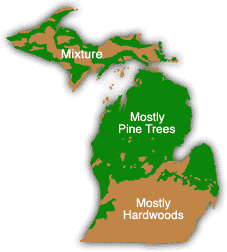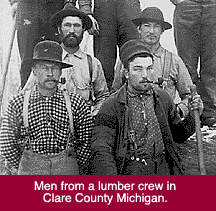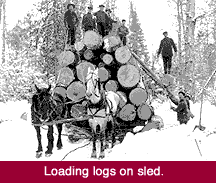The earliest lumbering was done by the French in order to build forts, fur-trading, posts and missions. The British, and later the Americans, used Michigans hardwoods to build merchant and war ships.
North of an imaginary line from Muskegon and Saginaw, the pines grew: white, jack and Norway, as well as other conifers. It was the white pine that allowed the heyday of the lumber industry. Many white pines were over 200 years old, two hundred feet in height and five feet in diameter.
Michigans pine became important as the supply of trees in the northeast was used. By 1880, Michigan was producing as much lumber as the next three states combined.
The first area where many mills were built was Saginaw. Six rivers converge to form the Saginaw River which empties into Saginaw Bay and then Lake Huron. The rivers are the Chippewa, Tittabawassee, Cass, Bad, Shiawassee and Flint. Rivers played a very important part for the loggers because the lumber had to be floated to the mills and then to market.
The first group of people to set up lumbering operations were from New England, especially Maine and New York. The forests there were almost entirely cut, so the owners and experienced crews followed the work. Many felt that the huge forests of Michigan would last for many, many years, yet within a 20 year period, 1870 to 1890, most of the trees were cut.
 The first people to understand the immensity of the woods were the government surveyors, but their job was to get information about the topography. The timber cruisers worked for the lumbermen and would select the best land available and reserve it at the land office for their employers. Much of this land sold for as little as $1.25 an acre; and later, under the Homestead Act (1862), men were hired to claim a plot of 160 acres and stay until the timber on it was cut.
The first people to understand the immensity of the woods were the government surveyors, but their job was to get information about the topography. The timber cruisers worked for the lumbermen and would select the best land available and reserve it at the land office for their employers. Much of this land sold for as little as $1.25 an acre; and later, under the Homestead Act (1862), men were hired to claim a plot of 160 acres and stay until the timber on it was cut.
After the timber cruisers found the best stands of pine, the crew would come in and build a camp, which consisted of a bunkhouse, cook shanty which had a dining room and kitchen, the most important part of camp. There was a blacksmith and a carpenter as well as a granary and barn for the animals. The camp store would have the basic supplies need by the men, such as clothes and tobacco. These buildings were not very well built, as they were often meant to be temporary, to be moved when the trees were gone. Each camp typically had two foremen, about seventy men, twenty teams of horses and seven yoke of oxen. The men came to the camp in late fall or early winter, as logging was a cold weather job. The food was plentiful, if boring. The usual meal wou ld be bread, potatoes, tea, beans and pork. The crews worked from about 4 a.m. until dusk, even eating the noon meal in the woods. The horses and oxen, on the other hand, were very well treated and rarely overworked.
ld be bread, potatoes, tea, beans and pork. The crews worked from about 4 a.m. until dusk, even eating the noon meal in the woods. The horses and oxen, on the other hand, were very well treated and rarely overworked.
The logs were far too big and heavy to take from the woods by dragging, so the loggers made ice-covered roads, where the logs could be pulled on sleds. The loads were often extremely big and contests were held between rival camps to see which could stack a load the highest. The logs were taken to the banks of rivers, where they were piled twenty to thirty feet high, awaiting the spring thaw. When rivers melted, the logs were pushed into the swollen rivers and floated to the mills. At the mills, the logs were sorted in the boom area, each identified by a log mark on the end of the logs. The were then sorted in the boom area, each companys logs together.
The logs were difficult to handle because of their size (16 feet) and quantity. When the mill had cut the wood into boards, it was dried and then put on ships heading to various areas. Much of the wood from Saginaw, for instance, went to the Northeast, where it was used for building cities and  homes. The wood from the west side of the state was shipped to Chicago, from which it was sent by train to the plains states to build homes, cities and railroad tracks.
homes. The wood from the west side of the state was shipped to Chicago, from which it was sent by train to the plains states to build homes, cities and railroad tracks.
As technology improved, the wood in Michigan was more quickly taken, especially with the introduction of the logging railroad in the 1850s. These small engines and their portable narrow gauge track made it possible to log farther away from the rivers. These railroads could haul loads of logs no matter the weather. Other improvements included the use of the crosscut saw to fell the trees much more quickly than the axe, the circular saw in the mills and the "big wheel" for logging in the summer months.
Many men made huge fortunes from the logging industry. These men are often called lumber barons, and Michigan had many. There also many other results of logging, including the growth of cities around the mills, the quick spread of farming (the land was easier to clear) and the change in Michigans environment after the trees were gone.
Much folklore arose from the camps and mills. The men were in the woods many months with only Sundays off. They often sang and made up stories, many of which are known today. The most famous is Paul Bunyon and Babe, the Blue Ox. This story, as well as others, were often based on real people and exaggerated in the retelling.
Sundays off. They often sang and made up stories, many of which are known today. The most famous is Paul Bunyon and Babe, the Blue Ox. This story, as well as others, were often based on real people and exaggerated in the retelling.
For every success story, there was one of failure or tragedy. Lumbering was dangerous and risky work. Men who worked in the camps were injured or killed. Investments in timber never paid off. Sawyers lost jobs as the mill burned to the ground. The logging era in Michigan still holds a fascination and glamour for many. The millions and millions of board feet of Michigan lumber truly helped build this country, but we will never see this again, as the trees are now gone.





